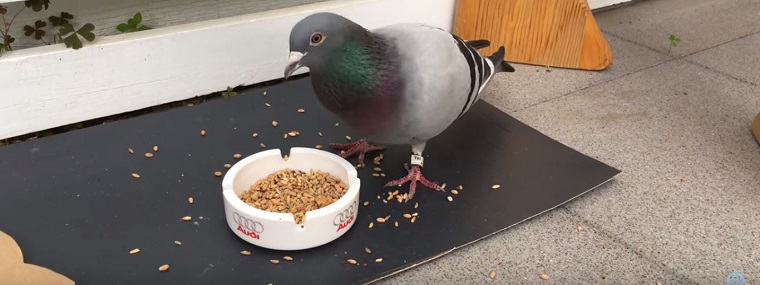|
|
|
|
Pigeon Repellents
Pigeons are Florida birds that have had a long and notable friendship with people. They are commonly known for their struts, tiny
head, gentility and adaptive ability. They are found deep within cities and down to suburban areas as well. Though soothing
and entertaining in nature, they can pose a high level of nuisance, environmental and health hazard ranging from fecal splatter
down to transmission of various diseases.

Areas commonly clustered by pigeons
Some common areas, mostly pest-ridden by pigeons includes, but not limited to, the following:
• Chimney pot
• Ride tiles
• Roof tiles
• Guttering
• Soffit
• Hooper
• Balconies
• Windowsill
• Flat roofs
• Gable end
• Light well
The Pigeon Problem Overview
Pigeons in urban and sub-urban habitat and their interactions with the environment can be thought of in many ways, alternating from
harmless birds to harmful pests. Dynamics identified as important in becoming a pest includes their high procreative rate, colonial
habits, roosting, corrosive fecal splatter, group rummaging and spread of diseases.
Corrosion and Damage to Buildings
Pigeon droppings are not only unpleasant; they are highly acidic, and attract pests, such as mice, rats, and flies, and possibly plague
away the underlying exterior. The corrosive nature of pigeon droppings has caused substantial damages to roofs, tar-based structures, and
has been known to cut the roof life enormously. This corrosion is so intense that many of the significant historical and architectural relics
are destroyed. The buildup of Florida pigeon droppings can damage the ends of the outer surface and the interior of the building and removal is difficult
and expensive. Their droppings can lead to hazards on pavements and they are proficient in lifting loose roof lids, tiles and battens gain entry
into the roof vacuums. This can significantly damage the structure by allowing water penetration, thus, providing the ideal environmental conditions
for the growth of wood rotting fungi and Wood boring insects leading to substantial decay. Pigeon feathers and feces in poorly maintained buildings
and environments can block gutters and hopper heads, allowing water penetration into the building fabric giving room for the major outbreak of dry
rot and wet rot.
Health Hazards
Pigeons populating the buildings or living on the facade presents an impending risk of infection to people in and around these buildings. According to
the New York City Department of Hygiene and Mental Health, there are three (3) main diseases humans may contract at a certain level of exposure to pigeon
droppings. Via:
• Histoplasmosis: A fungal infection contracted after breathing in the microscopic fungal spores from pigeon droppings with symptoms such
as fever and chest pains appearing in about 10 days after first infection.
• Cryptococcosis: type of fungus infection in pigeon droppings contracted through Inhalation of airborne fungi and spreads from person to person.
• Psittacosis: infectious disease of Florida birds, caused by chlamydia and transmissible to human beings as a form of pneumonia.
Other diseases associated with pigeon and their droppings include: Salmonella, listeria, E.coli, tuberculosis and Candidiasis
Pigeon Control in Practice
Pigeon control requires expertise, imagination as well as integrated approach which cuts across several strategies used in concert. Although an Act of
legislation deals with all matters on wildlife in every country, it does not offer any formidable pigeon control strategy and as such, managing the hazards
posed by these birds is solely dependent on the landowner or occupant. However, Florida pigeon control in practice is broken down into two categories; via: Natural
and store-bought repellents.
Natural Pigeon Repellents
Simply setting up barriers for the Florida pigeons, removing food cradles, grains, water sources, securing garbage cans, destroying their nests, protecting gardens
by netting or using motion-sensing sprinklers are some natural ways in practice to meet the pigeon nuisance control.
Other forms of Natural Repellents
• Netting: is the other effective choice and works greatly on taller buildings. It repels pigeon from perching on the roof or other parts
of the home. This method proves is ineffective as the birds are rather killed in the net than being repelled.
• Predators: However due to difficulty in providing enough predator animals that can help repel Florida pigeon this method is not really
effective.
• Spike: The pigeon spike is a wholesome perching product that is used exclusively to stop any species of wild bird from landing on flat
surfaces. However, clients that have had anti-roosting spikes installed as a means of protecting their environment often find the strips of spikes become
displaced, resulting in the system being compromised and pigeons gaining access to the exposed areas.
• Balloon scare: it is economical which is why many people might try it; however, long term prevention is not certain.
Store-Bought Pigeon Repellents
One of the artificially formulated repellent for pigeon known as the sonic bird repellent helps to keep birds away by emitting bird distress calls. But, in most
cases, this product does not really work well and expensive to buy and same goes for other sound emitting repellents. The bird gel is a gel you apply on the site
where pigeon lands likes to stand and it will make it an uncomfortable surface for it or you can adopt the scarecrow technique. Ultrasonic sound emitters may
very well produce noises humans cannot hear, but rarely are those sounds irritating to birds. If a Florida pigeon can manage the noise, congestion in a busy city, some
indiscriminate sounds from an ultrasonic radio will definitely not bother it. In conclusion, natural and store-bought repellents like nets and spikes are however
great to use, if only you seek a temporary solution and you do not mind always spending money.
We service the following areas:
Boca Raton,
Bradenton,
Cape Coral,
Fort Myers,
Fort Lauderdale,
Gainesville,
Jacksonville,
Lakeland,
Melbourne,
Miami,
Naples,
Ocala,
Port Saint Lucie,
Saint Augustine,
Sarasota,
Tampa, and
West Palm Beach
|
| © 2001-2018 floridawildlifecontrol.com - site content, photos, & maintenance by Florida Wildlife Control, all rights reserved. |
| | |